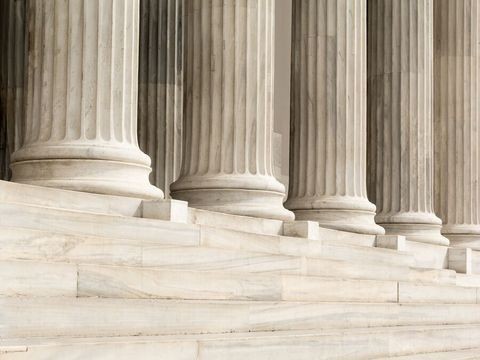Declaration of No Independence: President Trump Asserts Control Over Independent Agencies Through Executive Order
What You Need to Know
Key takeaway #1
This Executive Order is the latest in a series of actions by this Administration to assert maximal authority over all functions of the federal government that are not subject to the direct control of Congress or the federal courts.Key takeaway #2
If it stands, this EO effectively eliminates any political and policy independence of agencies such as the FTC, FERC, FCC, SEC, NLRB, CPSC, and EEOC from the White House.
Client Alert | 5 min read | 02.20.25
On February 18, President Trump issued an Executive Order titled “Ensuring Accountability for All Agencies” that directs independent agencies (as well as Cabinet Departments and their sub-agencies) to route all “proposed and final significant regulatory” and budgetary actions through the White House and the Office of Management and Budget. If implemented to its full extent, this action will significantly strengthen the authority of the White House by weakening the political autonomy of these independent agencies. As an assertion of the President’s inherent powers under Article II of the U.S. Constitution, it also stands to weaken congressional influence over these independent agencies, both through the appropriations and confirmation processes.
Although not without historical controversy, it has for nearly 90 years been understood that the heads of these types of agencies—which include numerous heavyweights such as the Federal Trade Commission (FTC), the Federal Communications Commission, the Securities and Exchange Commission, the National Labor Relations Board (NLRB), and the Federal Energy Regulatory Commission, all of which are led by Senate-confirmed appointees—enjoy a level of regulatory and budgetary independence from the President, manifested principally through statutory “for cause” protections from removal from office. In short, whereas the President’s Cabinet Secretaries (e.g., Secretary of State, Secretary of Labor, Secretary of Commerce), as well as the heads of their sub-agencies, serve at the pleasure of the President, the heads of independent agencies—typically but not always multi-member commissions or boards—have their terms set by statute and may not be removed from office unless they engage in misconduct.
In 1935, in a case arising from President Franklin D. Roosevelt’s firing of an FTC commissioner[1], the Supreme Court held that Congress may insulate agency heads from removal by virtue of Congress’ authority under Article I of the U.S. Constitution to create certain “administrative” bodies to carry out “legislative policies” free from interference by the President. In the Court’s estimation at the time, the FTC did not operate as an “executive” branch agency so much as a “quasi-legislative” or “quasi-judicial” agency.
Humphrey’s Executor has never sat well with those who hold the view that the U.S. Constitution creates only three branches of government, as defined by the first three articles: legislative (Congress), executive (the President), and judicial (the Supreme Court and lower courts established by Congress). This view endorses the so-called “unitary executive” theory, under which all agencies created to execute the law are inherently Executive Branch entities, the heads of which must be answerable directly to, and serve at the pleasure of, the President, in whom the Constitution vests all executive power. Under this theory, there is no space in our tripartite government for “independent” quasi-legislative or quasi-judicial bodies, which—if the logic of Humphrey’s Executor is to be followed—would constitute in effect a fourth branch of government. That, proponents argue, would violate principles of separation of powers by encroaching on the authority of the Executive, regardless of whether a President approved of the legislation and retains the power to nominate board members and designate board chairs.[2]
In the modern era, interest in the unitary executive theory gained steam in the Reagan administration and today seemingly has some support on the Supreme Court. In 2010, for example, the Supreme Court held that members of the Public Company Accounting Oversight Board (created by the 2002 Sarbanes-Oxley Act) could not operate independently of the President under cover of two layers of for-cause removal protections without violating the “vesting clause” of Article II[3]. In 2020, the Court held that the protections endorsed by Humphrey’s Executor applied only to “multi-member” agencies and not agencies run by a single director, thus negating the for-cause removal protections of the head of the Consumer Financial Protection Bureau.[4] Similarly, a year later, the Court said the same about the director of the Federal Housing Finance Agency[5].
The February 18 Executive Order expresses a maximalist view of presidential authority and was likely drafted with these relatively recent decisions in mind. In fact, it follows several recent actions by the Administration that have already staked out this territory, including (i) a letter of February 12 from the Acting Solicitor General, Sarah Harris, notifying Congress that the U.S. Department of Justice (DOJ) deems the for-cause removal protections for heads of independent agencies unconstitutional and that DOJ would pursue the overruling of Humphrey’s Executor at the Supreme Court to the extent that precedent was invoked to hamstring the President’s authority over those agencies; and (ii) an emergency application to the Supreme Court to vacate a district court temporary restraining order that restrains President Trump from terminating the head of the Office of Special Counsel, in which the Solicitor General flagged in a footnote the government’s position that Humphrey’s Executor should be overruled to the extent it impedes the President’s authority. These actions, in turn, follow multiple high-profile terminations by the President of commissioners and board members at several “independent” agencies, including the Equal Employment Opportunity Commission and the NLRB. Of note, the Executive Order makes one somewhat significant exception: it excludes decisions of the Federal Reserve Board regarding monetary policy.
All of this has historical precedent, as Humphrey’s Executor itself illustrates. If there is a difference now, it is one of scale. Two things seem certain: there is yet more to come; and the constitutionality of some or all of these actions will be decided by the Supreme Court.
Crowell attorneys advocate for its clients before, and advise its clients on compliance matters with respect to, a host of independent agencies, and will be tracking the implementation of this Executive Order to help clients prepare for or respond to the opportunities and risks it may create for affected businesses.
[1] Humphrey’s Executor v. United States, 295 U.S. 602 (1935)
[2]Seila Law LLC v. CFPB, 140 S. Ct. 2183, 2216 (2020) (Thomas, J., concurring in part and dissenting in part)
[3] Free Enterprise Fund v. PCAOB, 561 U.S. 477 (2010)
[4]Seila Law LLC v. CFPB, 140 S. Ct. 2183 (2020)
[5]Collins v. Yellen, 141 S. Ct. 1761 (2021)
Contacts
Insights
Client Alert | 5 min read | 12.12.25
Eleventh Circuit Hears Argument on False Claims Act Qui Tam Constitutionality
On the morning of December 12, 2025, the Eleventh Circuit heard argument in United States ex rel. Zafirov v. Florida Medical Associates, LLC, et al., No. 24-13581 (11th Cir. 2025). This case concerns the constitutionality of the False Claims Act (FCA) qui tam provisions and a groundbreaking September 2024 opinion in which the United States District Court for the Middle District of Florida held that the FCA’s qui tam provisions were unconstitutional under Article II. See United States ex rel. Zafirov v. Fla. Med. Assocs., LLC, 751 F. Supp. 3d 1293 (M.D. Fla. 2024). That decision, penned by District Judge Kathryn Kimball Mizelle, was the first success story for a legal theory that has been gaining steam ever since Justices Thomas, Barrett, and Kavanaugh indicated they would be willing to consider arguments about the constitutionality of the qui tam provisions in U.S. ex rel. Polansky v. Exec. Health Res., 599 U.S. 419 (2023). In her opinion, Judge Mizelle held (1) qui tam relators are officers of the U.S. who must be appointed under the Appointments Clause; and (2) historical practice treating qui tam and similar relators as less than “officers” for constitutional purposes was not enough to save the qui tam provisions from the fundamental Article II infirmity the court identified. That ruling was appealed and, after full briefing, including by the government and a bevy of amici, the litigants stepped up to the plate this morning for oral argument.
Client Alert | 8 min read | 12.11.25
Director Squires Revamps the Workings of the U.S. Patent Office
Client Alert | 8 min read | 12.10.25
Creativity You Can Use: CJEU Clarifies Copyright for Applied Art
Client Alert | 4 min read | 12.10.25
Federal Court Strikes Down Interior Order Suspending Wind Energy Development






